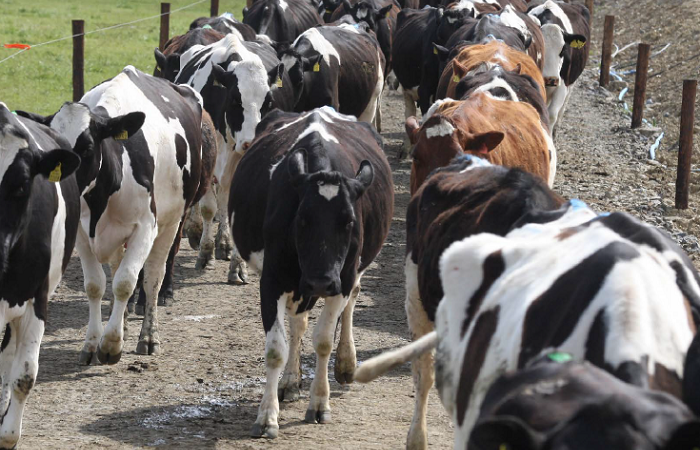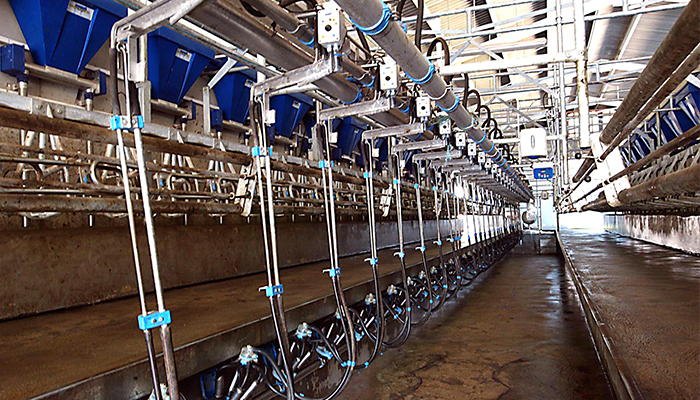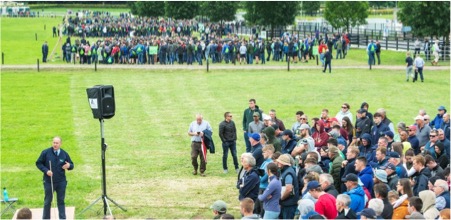Crowds were welcomed back to Moorepark today, July 4th, to see the research being conducted and to meet the Teagasc teams and industry stakeholders present.
Laurence Shalloo, Head of Animal & Grassland Research and Innovation Programme, Teagasc, Moorepark, welcomed those attending Moorepark ’23, while also highlighting many current and future challenges in the piece below. He explained that farmers who are informed and embrace new technologies will be in a better position to deal with those challenges as they arise.
Securing a sustainable future
The Irish dairy industry has undergone a transformational change since the removal of the EU milk quota in 2015. Since the Irish dairy industry began to prepare for EU milk quota removal in 2007-2009, milk solids output has increased by over 96%.
This increased output has been achieved through increased cow numbers, increased milk yield per cow, increased fat and protein percentages, increased grass growth, increased stocking rate and additional land entering the dairy industry.
Looking ahead, it is clear that the phase of rapid expansion that occurred after 31 years of milk quotas has now passed, and the industry is in a different phase of development. When the removal of milk quotas was first signalled, there were many questions and challenges facing the dairy industry including the level of expansion expected, the most appropriate milk production systems, developing and funding processing capacity, and identifying and securing markets for increased milk production.
These challenges were addressed by farmers, industry and stakeholders working together. The collective investments made at farm and processor levels have transformed the dairy industry, and were achieved with little increase in overall debt levels across the industry, even though the industry has doubled in size. As we look forward, there are immediate and future challenges to be addressed. A similar positive attitude towards these new challenges is now required to allow the dairy sector move forward in a sustainable manner. These challenges include competitiveness, greenhouse gas emissions, water quality, biodiversity, people, food security and dairy-beef.
Competiveness
Although there has been significant investment at both farm and industry levels, overall debt levels have remained relatively static at farm level, while debt levels per kg of milk solids produced have reduced significantly.
The largely grass-based systems of milk production have resulted in a low cost production system that has provided a comparative advantage for the Irish dairy industry within a seasonal profile of milk deliveries. Recently, published research studies indicate that Ireland’s competitive advantage has increased since milk quotas were removed. This was achieved through a constant focus on grazed grass in the diet, which will continue to be the key factor driving the competitiveness of milk production system, especially in the face of severe input price inflation as seen in 2022.
The benefits of the system have been further enhanced through the developments within the Economic Breeding Index, which have focussed on selecting a dairy cow with suitable attributes for the system (robust, high levels of fertility and survivability, ability to convert forage to milk, ability to withstand changes in feed supply).
The changes in the cost base observed at farm level in 2022 need an urgent focus at both farm and industry levels to ensure the cost increases can be reversed. Recent geo-political events have exposed the need for increased feed, fertiliser and energy security. Systems of milk production that rely less on purchased feed, fertiliser and energy are more resilient in these challenging times.
The industry must refocus, optimise pasture inclusion in the dairy cows’ diet and closely control costs at farm level. At industry level, efficiencies that facilitate cost control must be reviewed, and the additional processing capacity in the industry used to maximise industry returns and milk price. It may be time to review the A+B-C calculations (the C portion in particular) and evaluate whether the volume related processing costs should be increased to reflect increases in energy and other costs.
Greenhouse gases
The biggest and most serious challenge of our time is Climate Change. The Irish government declared a climate and biodiversity emergency in June 2019. Since then policy initiatives regarding climate have been developed, culminating in the Climate and Low Carbon Bill.
In July 2021, the Climate Action and Low Carbon Development (Amendment) Act 2021 was signed into law. The Act commits the Government to moving to a climate-resilient and climate-neutral economy by 2050.
The required reduction in emissions from Ireland is 51% by 2030 relative to 2018 across society, with an emissions reduction target for agriculture of 25%. These requirements are onerous, and only time will tell if they can be achieved and the implications that will arise if they cannot be achieved.
Clearly, the industry must now focus on the technologies that are currently available for implementation to reduce emissions. These include using EBI, reducing chemical nitrogen fertiliser use through the adoption of clover and better soil fertility, movement away from CAN based fertilisers to protected urea, drainage of mineral soils, etc.

These technologies will be published in a new Marginal Abatement Cost Curve (MACC) for agriculture in the second half of 2023. These currently available technologies can bring the industry on a significant part of the journey to achieve the sectoral targets, but there is also a requirement to develop new farm level technologies, which is a significant focus of current research investment.
Investment in research to develop country specific emission factors will ensure that the national inventory emission factors are accurate and robust. These include agriculture-based emissions (such as enteric methane across livestock classes) as well as land use and land use change based emissions.
Designing policy where these emissions and emission factors are not robust could result in that policy becoming outdated very quickly. After 2030, when we move to a climate/temperature neutrality goal, there will be a different set of metrics required that reflect the additional warming impacts of the various gases. This will be particularly important when it comes to short-lived gases like biogenic methane, where current metrics do not appropriately reflect the additional warming impact.
Water quality
The competitive advantage of pasture-based systems are based on maximising grass utilisation. Where stocking rate is not high enough to utilise the pasture grown on a farm, pasture utilisation and quality will be reduced, resulting in reduced animal performance.
Reducing the maximum stocking rate from 250 kg organic nitrogen per ha to 220 kg organic nitrogen per ha may tempt some farmers to move away from a pasture-based system in Ireland towards a European model of forage maize/high concentrate feeding system to increase output per cow when stocking rate is restricted.
International evidence indicates that these high input systems are more detrimental to the environment than pasture-based systems. It is anticipated that nitrogen losses from Irish grassland farmers will reduce significantly over the coming years. This will be achieved through significant reductions in chemical nitrogen fertiliser application (the Food Vision Dairy Group target to reduce chemical N by 27-30% by 2030), precision nitrogen fertiliser application, changes to slurry management and soiled water storage, higher livestock nitrogen excretion rates plus banding, and the extended closed period for chemical nitrogen fertiliser, as outlined in the 5th Nitrate Action Programme.
Better soil fertility, increased use of white clover, better grassland management practises and improved nitrogen management will minimise the impact of reduced nitrogen fertiliser application. It is estimated that these new regulations will result in a reduction of between 5.9 and 9.0 kg/ha of nitrate-N leached to one metre level on a grass-only based system. While this reduced loss at one metre level is not the same as reduced loss to rivers (the lag time can be from months to decades), it can be anticipated that the reduced loss will have a significant impact and will contribute to reduced N loads at the catchment levels over time.
Biodiversity
The Nature Restoration Law aims to restore ecosystems, habitats and species across the EU’s land and sea areas. The law will enable long-term and sustained recovery of biodiversity and promote resilient nature.
It will also contribute to climate mitigation and climate adaptation, as well as helping Ireland and the EU to meet international commitments. Restoring the agricultural ecosystems will include positively managing existing farm habitats and landscape features such as buffer strips, hedgerows, stone walls, field margins, woodland, trees, archaeological features, drains/ditches and ponds.
Existing schemes such as ACRES and EIP can help to contribute to restoring ecosystems. A large amount of research is required to identify the most appropriate solutions and their implementation on farms to enhance the quantity and quality of biodiversity.
People
The availability of people to work in the dairy industry is probably the biggest challenge on dairy farms today. Greater efforts are required to demonstrate the types and opportunities of jobs/careers that are available on dairy farms. This is particularly important given the current scenario where there is full employment within a buoyant economy.

The People in Dairy Initiative was launched in 2017 and identified a number of key focus areas that are still relevant today. It is necessary to develop long-term strategies around training, creating career pathways at all levels, providing appropriate farm facilities for staff, investing in farmer HR skills and implementing appropriate practices at farm level.
Developing seasonal business models that allow people to move between industries and creating a culture of awareness that dairy farms are rewarding and positive work places is required. Investing in technologies and practices that reduce the demand for labour will help address the supply/demand balance from both sides.
Food security
When milk quotas were introduced in the EU in 1984, the global population was 4.8 billion; in November 2022, the global population exceeded eight billion for the first time. As the global population grows, there is a corresponding requirement for more food. As population wealth increases, there has generally been a historic trend for increased demand for animal sourced proteins.
In recent years, there has been a significant scientific debate regarding the benefits of animal-based proteins in the human diet. A recent report by the FAO identifies the important contribution of animal source food (milk, meat, eggs) to healthy diets for improved nutrition and health outcomes. How that animal sourced protein is produced, and in particular, the overall impact on net human edible protein production, is an important consideration.
Several metrics have been developed to measure the net contribution of livestock to the supply of human digestible protein (HDP). The edible protein conversion ratio compares the amount of HDP in animal feed with the amount of HDP in the animal product.
The land-use ratio (LUR) compares the potential HDP from a crop grown on the land used to produce the livestock feed versus the quantity of HDP that livestock produce. For both metrics, Irish dairy performs well.
Irish dairy is providing a positive contribution to global HDP production, even where the opportunity costs of the land used for dairy are taken into account (LUR). In the context of global food production, two key questions arise: (1) does it make sense to feed animals food that humans could eat? (2) Should land be used to grow crops to provide food for humans rather than animals?
There is also a related question as to whether or not more of the ruminant products consumed globally should originate from regions and countries where ruminants do not compete for land use (land not suitable for growing crops, climate that better supports grass growth) for human edible crop production, such as in Ireland.
Dairy Beef
There is a significant opportunity associated with dairy beef in Ireland. There has been substantial growth in dairy calf-to-beef production since milk quotas were removed. Financial returns from the DairyBeef 500 Campaign suggest that there is potential to generate a net profit of greater than €1,000 per hectare (excluding a land and labour charge).
In this context, the dairy industry must embrace technologies like sexed semen and the Dairy Beef Index to deliver profitable genetics for both the dairy and beef farmer. There is an urgent need for joined-up strategies between the beef and dairy industries to develop profitable beef systems based on early-maturing animals (lower emissions) and can provide a reward to both the dairy and beef farmers, while helping to decarbonise agriculture.
The live export of calves is extremely important to satisfy a market demand, as well as alleviating a supply/demand imbalance within the Irish calf market associated with the seasonal nature of the dairy industry. A key component of calf transport centres on achieving satisfactory animal welfare, which must be underpinned by scientifically proven strategies that minimise animal discomfort and stress. Policies introduced at a national and EU level must be underpinned by science.



























